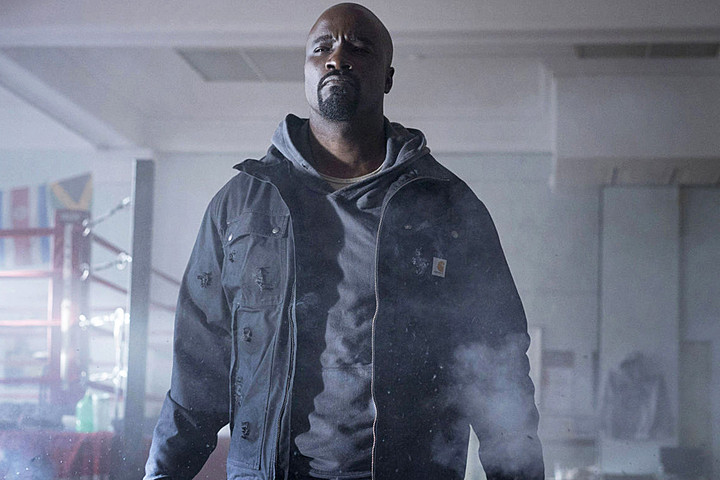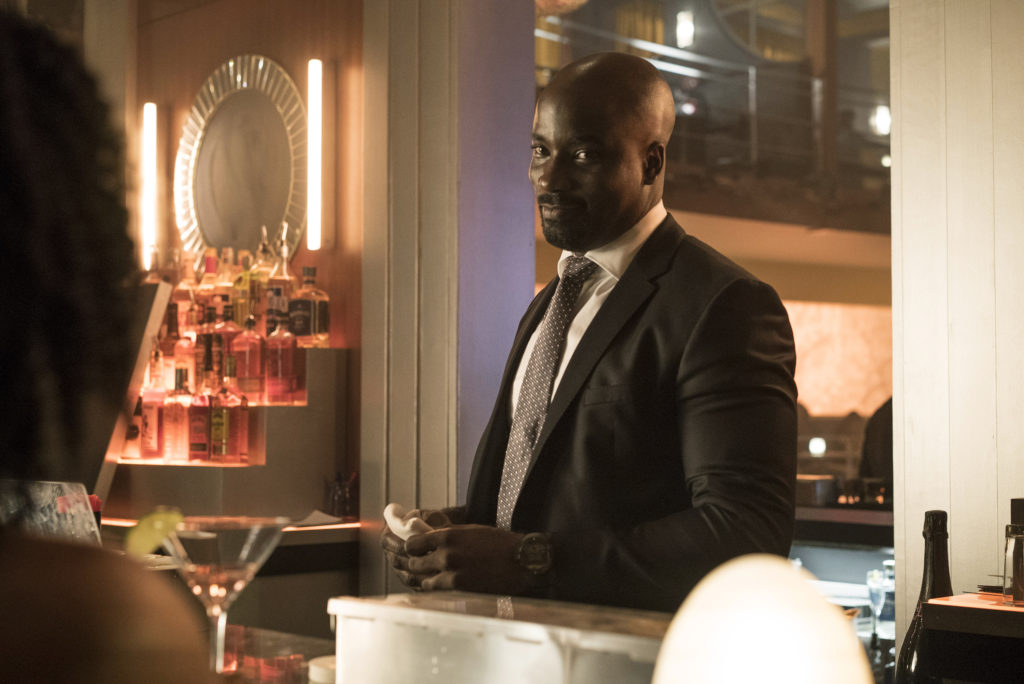Luke Cage and the Evolution of the Superhero Narrative
This guest post is part of our new blog series on Comics, Race, and Society, edited by Julian Chambliss and Walter Greason.

On September 30, 2016, Netflix released a TV adaptation of the 1972 comic Luke Cage. The 2016 series was a landmark in diversity both in terms of race (with a black show-runner, protagonist, and antagonists) and gender (much of the story revolves around Simone Missick’s straight-talking detective, Rosario Dawson’s altruistic nurse, and Alfre Woodard’s corrupt politician). The original comic–despite being “the first regular [comic] book with a black star”–certainly did not reflect this diversity.1
Composed by a group of mainly white Americans (Englehart, his predecessor Archie Goodwin, George Tuska, John Romita, Sr., and others), the comic book Luke Cage: Hero for Hire, for all its apparently progressive intentions, was firmly embedded in the culture of the time. The comic form, as I discuss in an earlier post, is an affirmation–subconscious or otherwise–of various unsavory attitudes. This post explores the key differences between the original Luke Cage comic book and the Netflix adaptation along the lines of race.
The first season of the TV series about Luke Cage (played by Mike Colter) consists of two main narratives. One concerns the origins of Luke’s superpowers—superhuman strength and bulletproof skin–in an abortive electrochemical experiment enacted by prison doctor Noah Burstein while incarcerated for a crime he did not commit. After an initial sub-plot involving Mahershala Ali’s gangster ‘Cottonmouth’ Stokes, the second narrative strand focuses on Luke’s conflict with the criminal Willis ‘Diamondback’ Stryker (Erik LaRey Harvey), who Cage realizes is his embittered half-brother. Stryker’s desire for vengeance against Luke leads him to frame the protagonist for the crime that lands him in jail, and then pursue him once he is released. This is the story that dominates the second half of the season, and the final fight between Cage and ‘Diamondback’ is its conclusion.
 These two narratives, however, only take up the first two issues of the 1972 comic; the TV adaptation is based on the first eighth of the opening volume of Luke Cage: Hero for Hire. The first point to be made, then, is that the original comic is far less focused than the TV series. There is a tightness—a concision—to the narrative that TV viewers experience, meaning that actions and their consequences have more weight. By extension, stories involving black identity and selfhood are given more consideration in the modern adaptation: an important point in a contemporary climate in which the Black Lives Matter movement have much currency.
These two narratives, however, only take up the first two issues of the 1972 comic; the TV adaptation is based on the first eighth of the opening volume of Luke Cage: Hero for Hire. The first point to be made, then, is that the original comic is far less focused than the TV series. There is a tightness—a concision—to the narrative that TV viewers experience, meaning that actions and their consequences have more weight. By extension, stories involving black identity and selfhood are given more consideration in the modern adaptation: an important point in a contemporary climate in which the Black Lives Matter movement have much currency.
The second point to be made about the original comic is to highlight the language used both by and about characters. The white figures Luke encounters in the original comic–across the social spectrum, from the tormenting prison guard Captain Rackham (Luke Cage: Hero for Hire, vol. 1, issue #1) to the experimenting physician Doctor Noah Burstein (#1, 2 onwards) or the crooked businessman Jasper Brunt (#4)–all speak in full, unabbreviated sentences, using what linguist David Crystal would describe as Standard English. Many of them, following blaxploitation tropes, are negative characters — but they all speak ‘correctly.’ The black characters, however, abbreviate words and sentences freely, and refer to people as “cat,” “baby,” and “jivemouth.”2
In this way, a hierarchy is unconsciously presented to the reader in which white characters of all classes ‘speak properly,’ and black characters are inferior. In the 2016 adaptation, however, a close associate of ‘Cottonmouth’ and ‘Diamondback’–and former co-inmate of Cage–is white (Theo Rossi’s ‘Shades’), yet speaks in the same vernacular as his African-American colleagues. These are all inhabitants of Harlem, and their language indicates that there is no racial hierarchy to their relationships. This is particularly interesting considering that the series producers changed the race of the ‘Shades’ character, who is black in the original comic, in order to flatten such hierarchies.
The language used in dialogue about the black characters is also significant. In the original comic, various black male characters are repeatedly referred to as ‘boy.’ In one issue, for example, the villain ‘Black Mariah’ even describes abandoning her black henchman to be caught by the establishment as “leav[ing] mah boys for de man.”3 Luke is often described like this, in spite of his superhero qualities and his proven ability to vanquish white foes. He is treated with a casual disregard and dismissal that harks back to the days of slavery, when black men were viewed by their white ‘masters’ as inferior. There is no such derogatory language in 2016, when ‘Cottonmouth’ Stokes sees the protagonist working as a barman in the first episode and asserts that he can “find something more suitable for a man [Luke’s] size” (Episode 1, ‘Moment of Truth’).

The most significant difference, however, concerns a phrase used in the title of the original comic. Luke is, as the subtitle explains, a ‘hero for hire.’ Whereas conventional–in other words, usually white–superheroes often help others because of a sense of justice, Luke’s motivation is mercenary, with the exception being the initial story about enacting vengeance on Stryker. Luke’s identity as a self-proclaimed ‘hero for hire’ sets him up in opposition to white superheroes, whose racial privilege enables the narrative of ‘superhero-ness’ to be about altruism. As a result, others look down on Luke’s attitude–most obviously Dr Noah Burstein: “I’ve heard how you’ve helped neighborhood merchants against Syndicate protection men. For a fee / Bit disillusioning from a so-called hero, isn’t it?” 4
Luke’s response to Burstein is perfectly understandable, and its final phrase has added resonance: “Folks hire security guards, Doc…private detectives…Why not someone like me?” And, later in the series, he is still focused on payment: “Put in an honest day’s work—expect my bread for it!” 5 The white artists like Englehart and Goodwin who created the original comic may have believed they were moving beyond racism, but through the very presentation of the central character they were actually rehearsing racist rhetoric about individual worth.

In the TV series, in contrast, Luke does the right thing in order to help Harlem and its residents. He also makes an explicit nod to Harlem’s cultural history, in the name of a political development plan that gets repeatedly name-checked: the New Harlem Renaissance. Luke reads the work of Ralph Ellison and Chester Himes, the episodes are named after tracks by the East Coast hip-hop group Gang Starr, there are cameos ranging from Faith Evans to Method Man, and there are discussions of fictional heroes created by Donald Goines and Walter Mosley.
The series shows how the African-American culture of its characters is more than window-dressing, and how Luke is a part of the culture for which he is fighting. Moving away from the original ideas about the character, black superheroes no longer have to be ‘for hire’ to justify their existence. Black superheroes are now free to behave altruistically. To do so is to act from a position of power: they can afford to stick up for others. They are free, ultimately, to occupy a world in which a black individual is no longer the commoditized ‘property’ of a world with undeniable roots in slavery.
Thus, the 2016 adaptation, in re-writing the original comic, does more than just use a more nuanced understanding of culture and race to re-fashion a stereotypical imagining of the black self by white men: it acts as a fundamental re-positioning of the idea of the black self. There have been black protagonists–even black superheroes (i.e. Falcon, Black Panther)–in relatively ethnically sensitive re-imaginings in recent years; but this is the first time a cultural product has undertaken to re-interpret racialized interactions so thoroughly. In terms of contemporary attitudes towards race in America, this shows that there has been considerable development in the forty-four years of Luke Cage’s existence.
The trouble is, for all its cultural awareness, this is a TV show about an incessant and not always fruitful struggle to get things done in Harlem: a narrative that persisted throughout the twentieth century and continues into the present. Luke’s address at the Harlem funeral of a close friend in Episode 5 shows how far representations of black identity have com. However, it also reveals a certain longing for something that remains a dream, given the conflict and violence that we see on the streets of the city:
I don’t believe in Harlem.
I believe in the people who make Harlem what it is.
Sam Knowles is a teacher, lecturer, and writer specializing in the study of race and form in culture. His first book, Travel Writing and the Transnational Author, was published by Palgrave in 2014. His forthcoming research project will consider the political histories of a number of transnational island spaces. He is also pursuing research into the uses of graphic novel/comic form in representing the political and social complexities of postcolonial existences. Follow him on Twitter @life_academic.

Excellent! But we should also note that while Shades is indeed white, he is also Latino: his name is Hernán Álvarez (his particular ethnic background goes unmentioned). This detail adds another layer to the representation of race and ethnicity in the series, reminding us that Harlem also has a significant Latinx community. And there are other important Latinx characters in the series: Domingo Colón (leader of the Puerto Rican gang, although his accent is clearly Mexican, his character is played by a Mexican-American actor), and Luke’s love interest and assistant, Claire Temple (played by Rosario Dawson; Claire’s mother is supposed to be Cuban, but her accent is not particularly convincing).
Thus, one can easily make the argument that the show could have done a better job at portraying the complexities and differences between these Latinx characters, in how they also shape the community of Harlem (and in this manner, go beyond the reduction of the US racial and ethnic imaginary to a dichotomy of blackness verusus whiteness). Sadly, the viewer ends up mostly with a superficial and stereotypical portrayal of Latinida, as Luke Cage’s sexualized reference in the last episode to the “robustness” of Claire’s “Cuban” coffee underscores (coffee is used as a playful metaphor of sex throughout the episodes).
Thanks, Kahlil — particularly for your concluding point, which is a great one (and one I hadn’t noticed). I did actually mention Shades/Álvarez’s Latinx identity — which is complicated by his being played by Rossi, a white American — but it didn’t make the editorial cut. (By no means always a bad thing: I do tend to go off on a tangent in footnotes at times…)